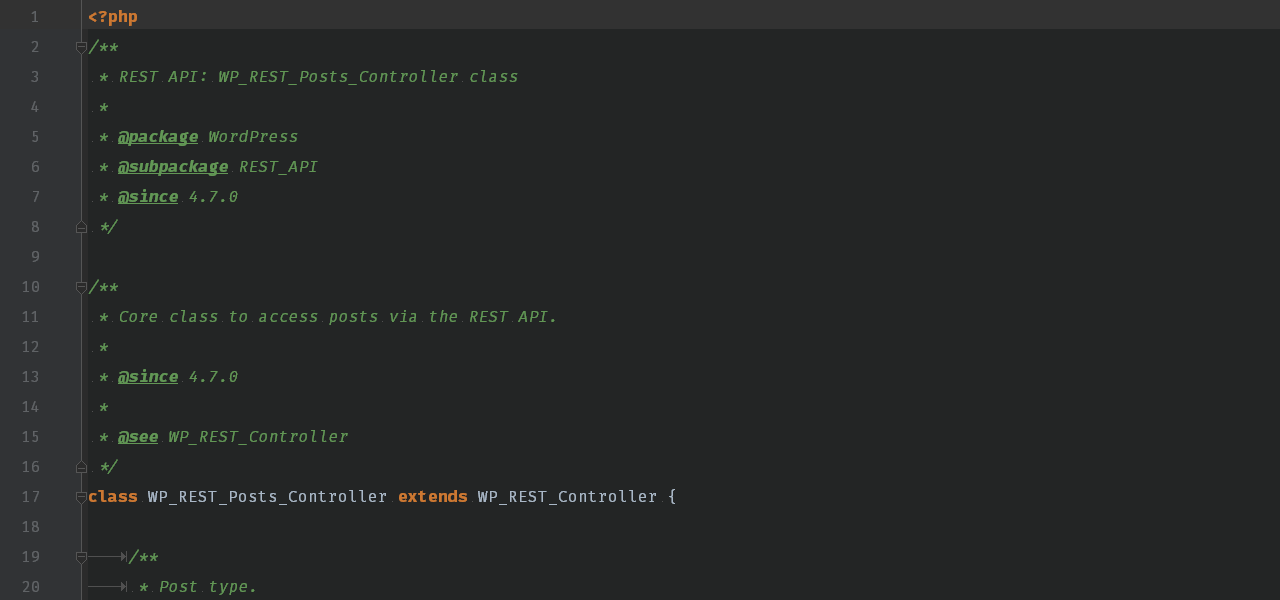REST in Pieces
Working with the WordPress REST API
in an Object-oriented Fashion
A talk by @thorstenfrommen
Who’s That Guy?

Thorsten Frommen
- Certified PHP engineer, web development professional, and tester.
-
WordPress engineer and technical project lead at

- Lead developer of MultilingualPress.
- Maintainer of WP REST Starter.
Looking Back
The history of the WordPress REST API:
- idea came up at WordPress Community Summit 2012;
- plugin (named JSON API) was started in December 2012;
- initially planned to merge into Core with WordPress 3.6 (August 1, 2013);
- infrastructure merged into Core with WordPress 4.4 (December 8, 2015);
- most endpoints merged into Core with WordPress 4.7 (December 6, 2016).
Looking Ahead
A possible future of the WordPress REST API:
- introduce more sophisticated authentication options;
- introduce (basic) JavaScript client;
-
enhance
wp/v2/usersendpoint to support multisite; -
introduce
wp/v2/sitesendpoint; -
introduce
wp/v2/networksendpoint.
Excursus: REST API
What is an API?
[An] Application Programming Interface (API) is a set of subroutine definitions, protocols, and tools for building application software. In general terms, it is a set of clearly defined methods of communication between various software components. Wikipedia
What is an API?
Stack Overflow
What is an API for Us?
For us,
an API consists of all means of communication with a specific piece of software.
What is REST?
Representational state transfer (REST) or RESTful Web services are one way of providing interoperability between computer systems on the Internet. REST-compliant Web services allow requesting systems to access and manipulate textual representations of Web resources using a uniform and predefined set of stateless operations. Wikipedia
What is REST?
Stack Overflow
What is REST for Us?
For us,
REST is a client–server architecture for providing interoperability regarding the
access and manipulation of resources by means of predefined stateless operations.
The WordPress REST API
Consequently, the WordPress REST API provides read/write access to (partial) data of a WordPress website, in a REST-compliant way.
Using
the WordPress REST API
List Posts
Send a GET request to the posts endpoint.
GET /wp-json/wp/v2/posts HTTP/1.1
Host: https://2017.vienna.wordcamp.org
Retrieve a Post
Send a GET request to the posts endpoint, and supply the post ID.
GET /wp-json/wp/v2/posts/3 HTTP/1.1
Host: https://2017.vienna.wordcamp.org
Delete a Post
Send a DELETE request to the posts endpoint, and supply the post ID.
DELETE /wp-json/wp/v2/posts/3 HTTP/1.1
Host: https://2017.vienna.wordcamp.org
Update a Post
Send an UPDATE request to the posts endpoint, and supply both an ID and new data.
UPDATE /wp-json/wp/v2/posts/3 HTTP/1.1
Host: https://2017.vienna.wordcamp.org
Content-Type: application/json; charset=utf-8
Content-Length: 46
{ "title": "Welcome to WordCamp Vienna 2017" }
Extending
the WordPress REST API
Writing a WordPress REST API Endpoint in 2 Minutes
add_action( 'rest_api_init', function () {
register_rest_route( 'tomjn/v1', 'test', [
'callback' => function () {
return 'moomins';
},
] );
} );
The WP_REST_Posts_Controller Class
 (Or: “OK, OK. I guess it doesn’t hurt to have a look at that WP REST Starter
thing.”)
(Or: “OK, OK. I guess it doesn’t hurt to have a look at that WP REST Starter
thing.”)
Current “Best Practices”
The suggested way to develop using the WordPress REST API:
- make use of a handful of (global, not pure) functions;
- maybe develop a custom endpoint on top of a huge abstract controller class.
“Why Is This Bad?”
- Following these practices results in procedural code.
- The code is not modular.
- Some parts of your code are redundant.
- There is no managing layer (or instances) available.
“Can You Do Better?”
Yes!
WP REST Starter
- Composer package (i.e., no plugin).
- Provides several interfaces for both data types and business logic.
- Comes with straightforward implementations for the common needs.
- Allows for proper object-oriented programming.
- Provides one level of abstraction.
WP REST Starter is
no Replacement
for Core Infrastructure
No Replacement for Core Infrastructure
-
Internally, uses functions such as
register_rest_route(). - You just don’t (have to) use the infrastructure directly anymore.
- Encapsulates logic within sensible structures.
WP REST Starter is
no Replacement
for Core Endpoints
No Replacement for Core Endpoints
- Integrates with Core endpoints (e.g., add field to response).
- Designed to be used for custom endpoints.
- Follows the way Core endpoints are set up.
Getting Started
Installation
Install with Composer:
$ composer require inpsyde/wp-rest-starter
Requirements
-
Minimum required PHP version:
- PHP 7
- PHP 5.4 (when using WP REST Starter v2)
-
Minimum required WordPress version:
- WordPress 4.7
- WordPress 4.4 (when defining custom REST routes only)
- ...or the WP REST API plugin
Contents of WP REST Starter
Contents of WP REST Starter
The package contains:
- 22 interfaces (10 × data type, and 12 × business logic);
- 12 implementations (3 × data type, and 9 × business logic);
-
4 factory/helper classes (e.g.,
WP_REST_Responsefactory).
Using
WP REST Starter
User Story I
I want to add a custom field to the response of an endpoint.
Without WP REST Starter
register_rest_field( 'post', 'awesomeness', $args );
With WP REST Starter
$fields = new Field\Collection();
$field = new Field\Field( 'awesomeness' );
// TODO: Set up $field (e.g., set reader callback).
$fields->add( 'post', $field );
( new Field\Registry() )->register_fields( $fields );
Benefits
- Separation of field definition and field registration.
- Field definition encapsulated in a dedicated object.
- Field registry serves as managing instance.
Looking at the Code: Field Collection
interface Collection extends \IteratorAggregate {
public function add(
string $resource,
Field $field
): Collection;
public function delete(
string $resource,
string $field_name
): Collection;
}
Looking at the Code: Field
interface Field {
public function definition(): array;
public function name(): string;
}
Looking at the Code: Readable Field
interface ReadableField extends Field {
public function set_get_callback(
Reader $reader = null
): ReadableField;
}
Looking at the Code: Reader
interface Reader {
public function get_value(
array $object,
string $field_name,
\WP_REST_Request $request,
string $object_type = ''
);
}
Looking at the Code: Field Registry
interface Registry {
const ACTION_REGISTER = 'wp_rest_starter.register_fields';
public function register_fields( Collection $fields );
}
Looking at the Code: Field Registry Implementation
final class Registry implements Common\Field\Registry {
public function register_fields( Common\Field\Collection $fields ) {
do_action( Common\Field\Registry::ACTION_REGISTER, /* args */ );
foreach ( $fields as $resource => $resource_fields ) {
foreach ( $resource_fields as $field_name => $field ) {
register_rest_field(
$resource,
$field_name,
$field->definition()
);
}
}
}
}
User Story II
I want to register multiple custom routes (or even endpoints).
Without WP REST Starter
register_rest_route( 'awesomeness/v1', 'foos', $args );
register_rest_route( 'awesomeness/v1', 'foos/(?P<type>\d+)', $args );
// ...
register_rest_route( 'awesomeness/v1', 'bars', $args );
Issue: redundant (hard-coded) data.
With WP REST Starter
$routes = new Route\Collection();
// ...
$routes->add( new Route\Route( 'foos', $args ) );
$routes->add( new Route\Route( 'foos/(?P<type>\d+)', $args ) );
// ...
$routes->add( new Route\Route( 'bars', $args ) );
// ...
( new Route\Registry( 'awesomeness/v1' ) )->register_routes( $routes );
Benefits
- Separation of route definition and route registration.
- Route definition encapsulated in a dedicated object.
- Registry serves as managing instance.
- Registry abstracts namespace (i.e., common information).
Looking at the Code: Route Collection
interface Collection extends \IteratorAggregate {
public function add( Route $route ): Collection;
public function delete( int $index ): Collection;
}
Looking at the Code: Route
interface Route {
public function options(): array;
public function url(): string;
}
Looking at the Code: Route Registry
interface Registry {
const ACTION_REGISTER = 'wp_rest_starter.register_routes';
public function register_routes( Collection $routes );
}
Looking at the Code: Route Registry Implementation
final class Registry implements Common\Route\Registry {
// Constructor, taking the namespace.
public function register_routes( Common\Route\Collection $routes ) {
do_action( Common\Route\Registry::ACTION_REGISTER, /* args */ );
foreach ( $routes as $route ) {
register_rest_route(
$this->namespace,
$route->url(),
$route->options()
);
}
}
}
User Story III
I want to use PSR-7 middleware in my RESTful WordPress project.
Excursus: PSR
PHP Standard Recommendations
- PSR stands for PHP Standard Recommendations.
- Maintained by the PHP Framework Interop Group.
-
Well-known PSRs:
- PSR-2: Coding Style Guide;
- PSR-4: Autoloading Standard;
- PSR-7: HTTP Message Interfaces.
HTTP Message Interfaces
- PSR-7 concerns itself with HTTP messages such as requests and responses.
- Package contains interfaces for HTTP messages and related structures (e.g., URI).
- There are quite a few PSR-7 implementations.
- There is lots of middleware designed to work with implementors.
Implementing PSR-7 in WordPress
“Can’t be that hard, can it?”
Well, … unfortunately, it is!
PSR-7 Request and Response
interface MessageInterface { /* ... */ }
interface RequestInterface extends MessageInterface { /* ... */ }
interface ResponseInterface extends MessageInterface { /* ... */ }
interface ServerRequestInterface extends RequestInterface { /* ... */ }
WordPress (REST) Request and Response
class WP_HTTP_Response { /* ... */ }
class WP_REST_Request implements ArrayAccess { /* ... */ }
class WP_REST_Response extends WP_HTTP_Response { /* ... */ }
¯\_(ツ)_/¯
WordPress get_headers() Method
class WP_REST_Request implements ArrayAccess {
/** @return string[][] */
public function get_headers() { return [ 'k' => [ 'v1', 'v2' ] ]; }
}
class WP_REST_Response extends WP_HTTP_Response {
/** @return string[] */
public function get_headers() { return [ 'k' => 'v1, v2' ]; }
}
(╯°□°)╯︵ ┻━┻
Goal
class Request extends \WP_REST_Request
implements Psr\Http\Message\ServerRequestInterface {
// ...
}
class Response extends \WP_REST_Response
implements Psr\Http\Message\ResponseInterface {
// ...
}
Status: work in progress!
Take-aways
- WP REST Starter brings proper OOP to your RESTful WordPress projects.
- WP REST Starter does not replace, but adds to the WordPress REST API.
- Please, use it, and maybe even contribute to it.
- Inpsyde is hiring! :)

